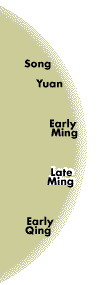

Figure painting, neglected since the Song dynasty, became prominent again in the late Ming, especially in the work of Chen Hongshou. This handscroll was a collaboration between Chen, his studio assistant Yan Zhan, and a portrait specialist named Li Wansheng. Li painted the face of the old gentleman He Tianzhang, using the new illusionism derived from acquaintance with European pictures. Three levels of reality and artifice are clearly distinguished in this portrait. He Tianzhang, seated at a stone table and surrounded by the accoutrements of a scholar, is a "real person" looking complacently out at us; the diminutive flute player at the end of the scroll is, on the other hand, a conventional image from the past, without substance. He Tianzhang's wife or concubine, seated between them on a banana leaf and holding a fan, occupies a mediating position in the mode of representation-she is given some weight and prominence, but is reduced to a type of beauty, presented more as a lovely possession than as an individual. Such refinements of style and subtle plays on representation bespeak both a highly sophisticated audience and an art that has become almost incapable of straightforward imagery.
